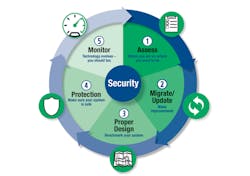Though machine communication has existed for decades, the level of interconnectedness that is today’s Industrial Internet of Things (IIoT) means it’s more leveraged than ever. With IoT’s impact on the global economy estimated at more than $11 trillion within the next 10 years—and the biggest gains coming in the industrial sector—few people still question the value of getting connected.
The why of IIoT is well documented, with business cases abounding. But the how of IIoT can still be somewhat elusive for many manufacturers.
At this year’s Belden IEI Design Seminar in Schaumburg, Ill., John Herold, Belden’s vice president of global industrial marketing, explained more about the how of IIoT—how to go beyond the theories and concepts, and actually get started. From Belden’s perspective, there are five key steps to realizing the benefits:
- Assess. Understand your goals and what you already have in place—where it lives, what it does, who owns it and who manages it. Know what’s connected, whether wired or wireless. “The result is an accurate map of the customer’s infrastructure,” Herold said.
- Migrate or update. With so much legacy production equipment throughout industry, it’s important to make sure the machines are prepared to communicate within the network. There are several ways to accomplish that, Herold said. “What needs to be updated? What needs to be new? What can stay as is? Is your infrastructure already running on Ethernet? If not, I recommend doing that step.”
- Proper design of new network/infrastructure. Really look at your network, Herold advised, thinking about segmentation, with properly designed zones and conduits. “Consider wireless technology, but use the right combination,” he said. “It doesn’t make sense in many cases; however, in some cases, it absolutely makes sense.” Wireless technology can help considerably in reconfiguring a production line, he added, providing more flexibility.
- Protection. Of course, with all this connectivity comes more security risk—both internal and external, accidental and intentional. “A connected production line is way more vulnerable than a standalone line. It needs to be ensured, or nobody will invest. It’s not necessary to protect everything, but you have to identify areas that really need to be protected,” Herold said. “Usually security is a matter of how much money you want to invest. So you focus on the critical assets first.”
- Monitor. As technology continues to evolve, you will need to also. “We want to make sure the customer is set up for ongoing monitoring and troubleshooting,” Herold said. Make a plan for regular maintenance, follow and incorporate evolving best practices, and monitor constantly, paying attention to system failure alerts and established response protocols.
IIoT is good for business, and you can start making an impact on manufacturing today, Herold emphasized. “It’s not new, it’s just now getting more attention; it’s more leveraged than it used to be,” he said. “There are more ways to connect things with each other, and we can see the exponential growth with devices.”
Belden has made a strong play in the IIoT space through innovations in signal transmission, for example, and also through brands it has acquired over the years. With the Hirschmann brand, acquired more than eight years ago, has come the rise of IT networking, Herold noted. “We were one of the first companies really driving Ethernet technology,” he said. “And Hirschmann was one of the first to develop products for the Industrial Internet of Things.”
Belden points to several IIoT applications from its brands across industries: Hirschmann supplied coach-to-trackside video monitoring infrastructure for a major metro rapid transit system operator in Southeast Asia; Garrettcom industrial frame routers enable connectivity and monitoring of RTUs and safety elements distributed across the Western U.S. for a major power utility; Hirschmann RSP switches and Eagle firewalls are incorporated into a system for the pilot production line of the SmartFactory KL technology initiative; and ProSoft cellular connectivity solutions provide remote monitoring and diagnostics information on pressure and other valve parameters on a remote pipeline in the southern U.S.
Other acquisitions—namely Byres Security (Tofino) and more recently TripWire—answer the call for a key concern building around such high levels of connectivity: cybersecurity.
Belden acquired TripWire earlier this year. “They focus on cybersecurity from a pure software perspective,” Herold said, noting that Belden has traditionally focused more on the hardware. “We’re now in the process of combining that so we can provide a complete solution.”

